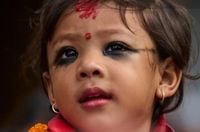On a bright October morning in Kathmandu, Nepal, a centuries-old tradition unfolded in front of crowds of devotees, officials, and family members. The city’s winding alleys echoed with the sound of drums and the scent of incense, marking the enthronement of a new Kumari, or living goddess—a ritual that has fascinated locals and outsiders alike for generations. This year, the role has passed to a toddler: two-year-old Aryatara Shakya, a child whose life changed overnight from ordinary to extraordinary.
According to reports from Extra.ie and the Associated Press, Aryatara Shakya’s appointment as Nepal’s next living goddess Kumari followed a rigorous and ancient selection process. The ceremony, held on Sunday, October 5, 2025, at Kathmandu’s historic Ghar Kumari House, drew crowds eager to witness the continuation of a tradition unique to the Himalayan nation. Dressed in a striking red gown and adorned with thick black eyeliner, Aryatara was carried by family members from her home to the palace, her feet never touching the ground—a rule that will define her movements for the years to come.
The Kumari tradition is steeped in symbolism and religious reverence. The living goddess is considered the earthly embodiment of Taleju, a Hindu goddess worshipped by both Hindus and Buddhists in Nepal. The belief is that the mere sight of the Kumari brings good fortune and blessings. As K24 Digital notes, devotees lined the streets, eager to touch their foreheads to Aryatara’s tiny feet—a gesture of utmost respect—and to offer her flowers and money. Even Nepal’s president is expected to seek her blessing, a testament to the Kumari’s enduring significance in national life.
The selection of a Kumari is no simple feat. Only girls from the Shakya clans of the Newar community, indigenous to the Kathmandu Valley, are eligible. The process is overseen by senior Buddhist Bajracharya priests, the Chief Royal Priest, and a royal astrologer. Candidates must be between two and four years old and meet a dizzying list of physical and astrological criteria: flawless skin, hair, eyes, and teeth; no scars or blemishes; all baby teeth intact; and even eyelashes like a cow, a neck shaped like a conch shell, and a chest like a lion. Their horoscope must also match that of the king.
But physical perfection is just the beginning. The most daunting part of the process is the so-called Trial of Bravery. As detailed by Extra.ie and Daily Mail, Aryatara was required to witness several buffalo sacrifices and masked men dancing in blood. The test is designed to ensure the child shows no fear—any sign of distress would disqualify her. Only after passing this test was Aryatara deemed worthy of embodying the goddess Taleju.
Once chosen, the Kumari leaves her family—her parents and even her twin brother—to live in the Kumari Ghar, a centuries-old palace in Kathmandu’s Durbar Square. The life of a Kumari is one of seclusion. She is allowed outside only a handful of times each year for festivals, such as the Indra Jatra and Dashain, when she is paraded through the streets in a golden palanquin. During these rare outings, her feet must never touch the ground. Devotees believe that the Kumari’s presence can bring healing and predict the future; her reactions during audiences—crying, laughing, or trembling—are interpreted as omens for the visitor’s fate.
Before Aryatara, the position was held by Trishna Shakya, who served as Kumari from 2017 until she reached puberty, the traditional threshold marking the end of a Kumari’s tenure. As soon as a Kumari begins menstruation, she is considered to have lost her divine status and returns to ordinary life. The transition can be jarring. Former Kumaris often struggle to adjust, learning to do chores and attend regular schools after years of isolation. Nepalese folklore even holds that men who marry a former Kumari may die young, leading many to remain unmarried.
Despite its deep roots, the Kumari tradition has not been immune to modern scrutiny. Human rights organizations and child welfare advocates have long criticized the system for its impact on the girls’ education and social development. Until recently, Kumaris spent most of their time in dimly lit rooms, with little access to education or the outside world. But, as Extra.ie and K24 Digital report, recent reforms have brought significant changes. Aryatara and other Kumaris now have private tutors, access to books, music, and even the internet. National exams are held inside the palace, and television sets have made their way into the Kumari Ghar. The government has also introduced a small monthly pension—about $110—for retired Kumaris, a sum slightly above the national minimum wage.
The role remains a double-edged sword. For the Shakya family, the honor is immense. Aryatara’s father, Ananta Shakya, told K24 Digital, “She was just my daughter yesterday, but today she is a goddess.” He recalled that his wife dreamed during pregnancy that their child would be special, a sign, he believes, of Aryatara’s destiny. The family’s social standing has risen, but the personal cost is high: parents see their daughter only during special events, around 13 times a year.
Still, the allure of the Kumari endures. The ritual is believed to bring luck and prosperity not just to individuals, but to the entire nation. Even Nepal’s highest officials—prime ministers and presidents—have been known to touch the Kumari’s feet and seek her blessings. The courtyard in front of the Kumari’s window is a place of pilgrimage, with visitors hoping to catch a glimpse of the living goddess. For many, the tradition is a vital link to Nepal’s cultural and religious identity, a living symbol of the country’s unique blend of Hindu and Buddhist beliefs.
As Aryatara settles into her new life, the world watches with a mix of awe and concern. Her days will be closely monitored, her actions interpreted as omens, and her every move steeped in ritual. But thanks to recent reforms, her experience may be less isolating than those of her predecessors. With access to education and the outside world—if only through books and screens—Aryatara’s years as Kumari may bridge the gap between ancient tradition and modern rights.
The appointment of Aryatara Shakya as Nepal’s new living goddess Kumari is a powerful reminder of the enduring pull of tradition, even as society evolves. For now, the eyes of a nation—and indeed, the world—are on this remarkable two-year-old, whose journey from child to goddess will shape her life and the lives of those who revere her.





